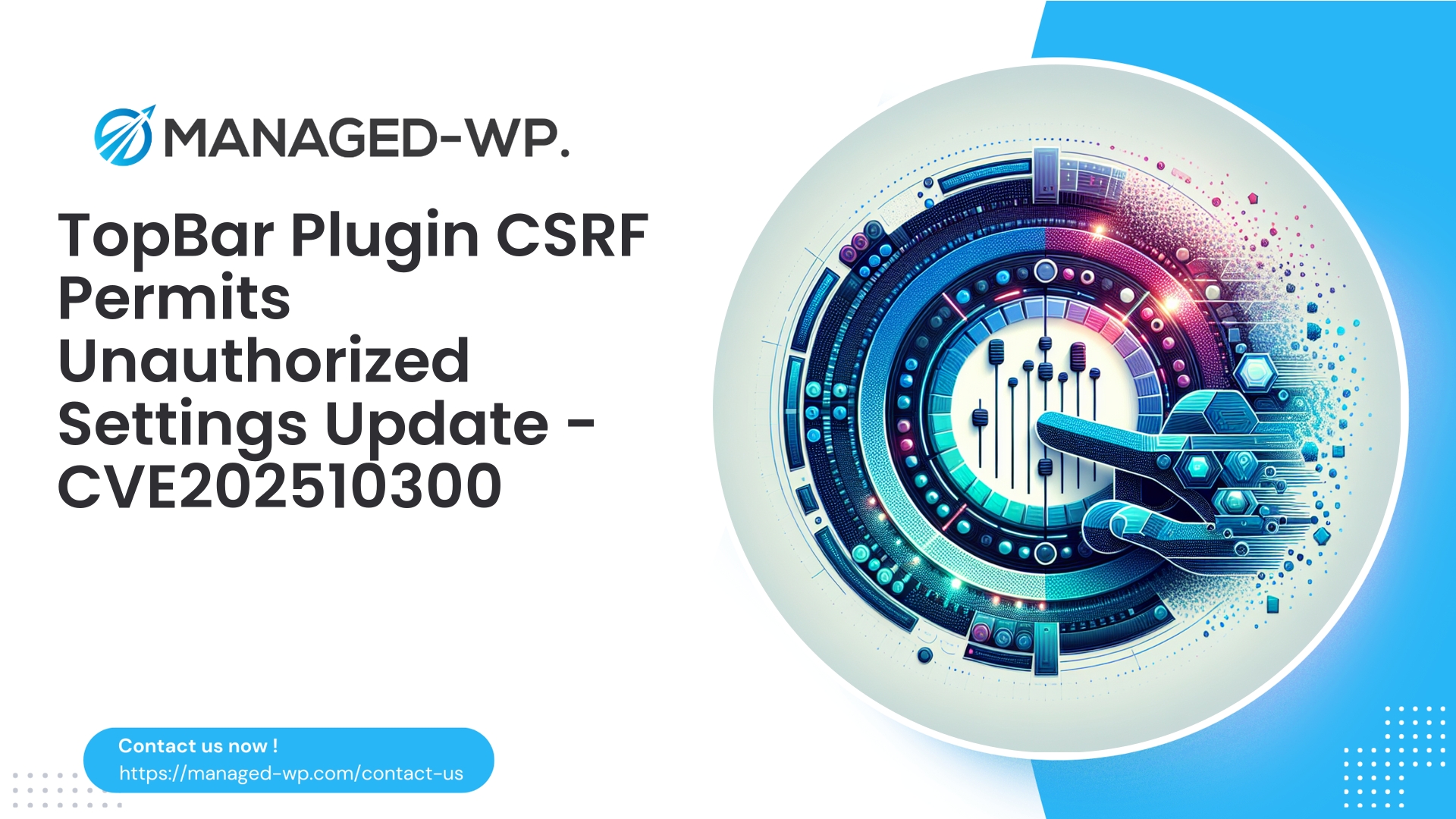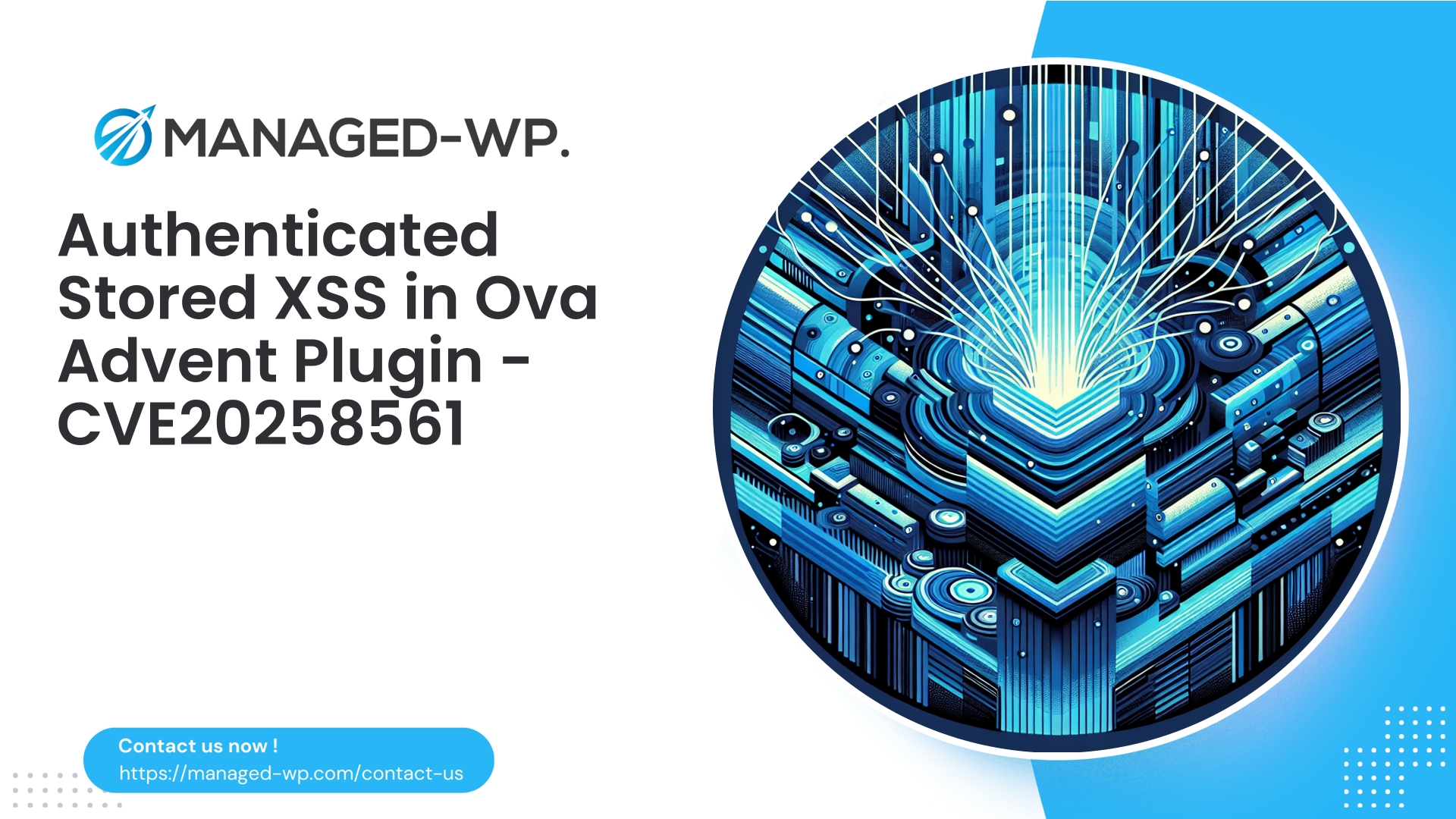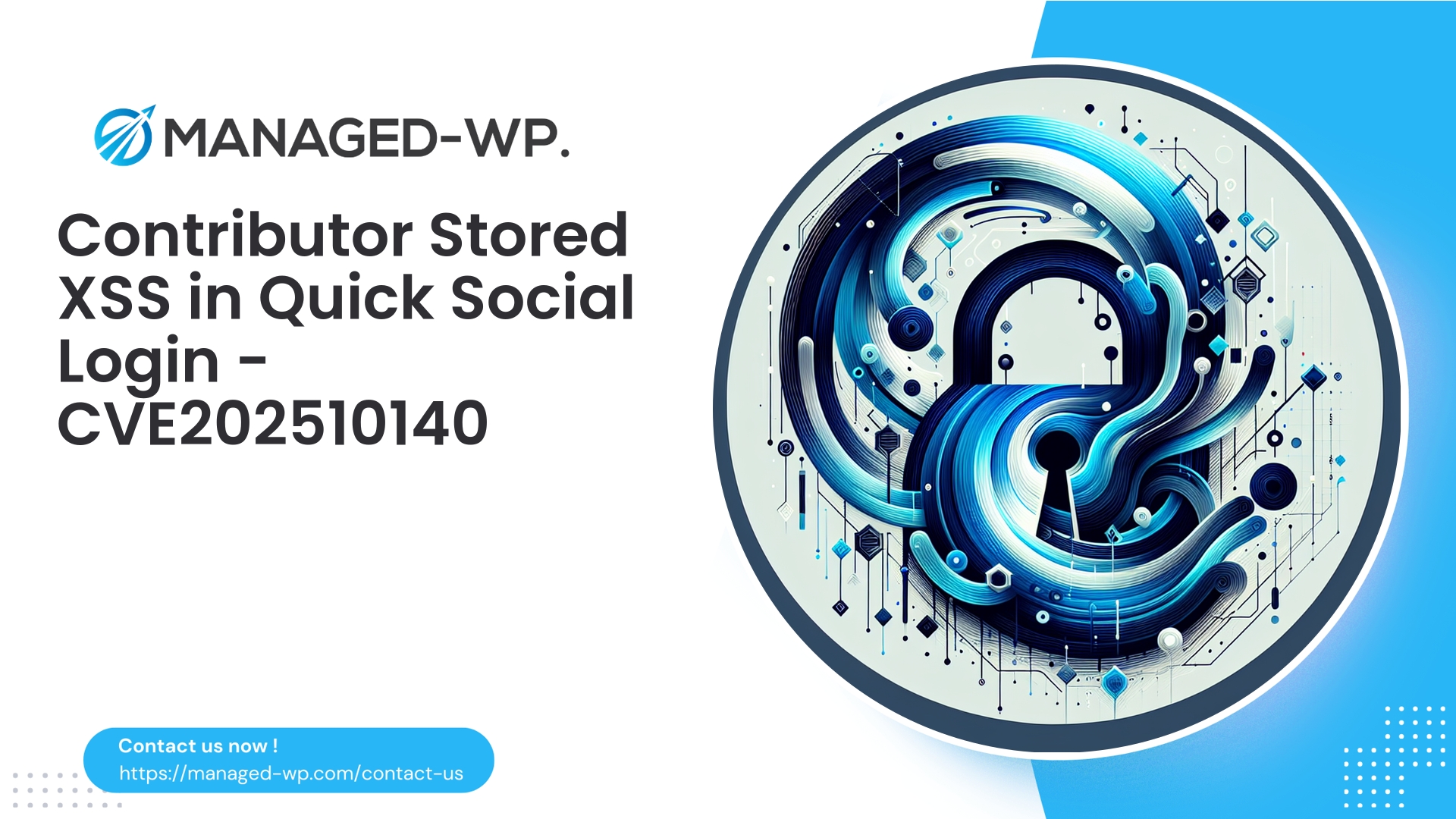| 插件名稱 | 頂部欄 |
|---|---|
| 漏洞類型 | CSRF |
| CVE編號 | CVE-2025-10300 |
| 緊急 | 低的 |
| CVE 發布日期 | 2025-10-15 |
| 來源網址 | CVE-2025-10300 |
緊急公告:TopBar (≤ 1.0.0) CSRF 漏洞 (CVE-2025-10300) – WordPress 網站所有者和開發者的緊急指南
作者: 託管式 WordPress 安全專家
日期: 2025-10-16
標籤: WordPress、安全、CSRF、WAF、漏洞、事件回應
本安全警示涵蓋了 TopBar WordPress 外掛程式(1.0.0 及更早版本)中新揭露的安全漏洞。此漏洞為跨站請求偽造 (CSRF) 漏洞,攻擊者可利用該漏洞未經授權修改外掛程式設定。 Managed-WP 提供此簡報,其中包含具體的風險分析、可操作的緩解建議(包括我們的虛擬修補程式解決方案)以及針對外掛程式開發者的清晰程式碼安全指南。我們的方法體現了美國安全專業人員在管理高價值 WordPress 部署時的實際需求。
執行摘要
被辨識為 CVE-2025-10300 的 CSRF 漏洞會影響 TopBar 外掛程式版本 1.0.0 及更早版本。利用此漏洞,攻擊者可以誘使已通過身份驗證的管理員的瀏覽器在後台靜默更新插件設置,從而可能在未經明確授權的情況下改變網站行為。
風險概覽:
- CVSS評分: 4.3(低)-由於需要管理員身份驗證,並且在許多情況下實際影響有限。
- 威脅等級: 利用網路釣魚或社會工程進行定向攻擊是主要風險來源;大規模自動化攻擊的可能性不大。
- 官方補丁狀態: 截至本通知發佈時,尚無其他應對措施,需要立即採取措施。
如果您管理 WordPress 環境,本指南包含識別易受攻擊實例、阻止攻擊和製定補救計劃的關鍵步驟,這些步驟將由 Managed-WP 專業維護的託管防火牆服務提供支援。
WordPress外掛程式中CSRF的作用與風險
跨站請求偽造 (CSRF) 攻擊利用應用程式對已認證使用者瀏覽器的信任。具體來說,當管理員登入 WordPress 時,攻擊者可以利用會話 cookie 和不完美的安全機制,誘騙瀏覽器發送未經授權的命令。
在 WordPress 中,CSRF 主要針對管理介面和會改變網站狀態的 AJAX 端點,例如更新外掛選項或使用者資料。有效的防禦措施要求使用安全的加密 nonce,並結合權限檢查。當前使用者可以())在應用更改之前。
當插件未能正確驗證這些保護措施時,攻擊者可以部署惡意網頁,這些網頁會靜默地提交精心建構的請求,透過已登入管理員的權限操縱插件設置,而無需獲得許可。
TopBar漏洞(CVE-2025-10300)詳情
- 受影響的插件: 頂部欄
- 易受攻擊的版本: 1.0.0 及更早版本
- 漏洞類型: 跨站請求偽造影響設定更新
- CVE ID: CVE-2025-10300
- 嚴重程度評級: 低(CVSS 4.3)
- 補丁狀態: 目前尚無官方修復方案
技術概要: 該插件公開了一個用於更新設定的管理處理程序,但該處理程序缺乏適當的 nonce 驗證和功能檢查。當已認證的管理員造訪惡意網站時,其瀏覽器可能會在不知情的情況下提交攻擊者指定的設定變更。
關鍵實用要點:
- CSRF攻擊需要受害者的瀏覽器被認證為管理員或特權使用者。
- 影響取決於特定變更的設置,其影響範圍可能從外觀上的影響到啟用後門或遠端內容加載,從而增加持續受到攻擊的風險。
真實世界的攻擊場景
- 網路釣魚引發的 CSRF:
- 攻擊者誘騙 WordPress 管理員造訪攻擊者控制的網站。
- 這些惡意網站會自動提交偽造的 POST 請求,從而修改 TopBar 插件的設定。
- 它們可能會啟用惡意重定向、注入遠端腳本或在不被察覺的情況下更改安全相關配置。
- 有針對性的違規行為:
- 針對特定組織的攻擊者會發現 TopBar 的存在,並利用這種 CSRF 向量為更深層的入侵做準備。
- 機會主義攻擊:
- 低技能攻擊者會廣泛嘗試社會工程攻擊,但要求進行身份驗證的管理員會話限制了攻擊面。
網站所有者和管理員應立即採取的措施
Managed-WP 建議優先執行以下操作,其中許多操作已整合到我們的託管防火牆產品中:
- 識別受影響的系統:
- 檢查您的 WordPress 安裝中是否有 TopBar 以及 TopBar 的版本(≤ 1.0.0)。
- 使用 WP-CLI 或管理員外掛程式清單來驗證版本。
- 停用或移除外掛程式:
- 如果可行,請立即卸載插件以消除風險。
- 如果功能至關重要,則在更新之前繼續採取緩解措施。
- 限製管理員風險敞口:
- 提示所有特權使用者登出並更改憑證。
- 建議不要在管理員活動期間瀏覽未知或可疑網站。
- 加強門禁控制:
- 盡可能對 wp-admin 強制執行 IP 位址白名單。
- 強制使用雙重認證以減少社會工程攻擊的影響。
- 先前剝削審計:
- 檢查外掛程式設定是否有可疑更改,包括遠端 URL 或新的 webhook。
- 檢查使用者活動日誌和伺服器日誌,查看是否有異常的 POST 請求。
- 執行惡意軟體掃描和完整性檢查。
- 套用虛擬補丁:
- 部署託管 WAF 規則,攔截並阻止針對 TopBar 端點的惡意請求。
- Managed-WP 客戶端會立即收到針對此漏洞的保護簽名。
- 制定長期補救計畫:
- 密切注意廠商更新,並在官方補丁發布後及時應用。
- 考慮遷移到積極維護的替代插件,以避免遺留問題風險。
入侵和偵測指標
時刻警惕剝削跡象,例如:
- 外掛程式設定發生意外更改,尤其是涉及遠端資源 URL 或管理員聯絡人的更改。
- 新增管理員帳號或權限提升。
- 異常的出站連接,連接到未知域。
- 對核心文件或外掛程式檔案進行更改。
- Web 伺服器日誌顯示管理區域的 POST 要求有可疑或缺少 referer 標頭的情況。
如果您識別出相關指標:
- 隔離受影響區域以防止擴散。
- 建立取證備份。
- 輪換所有敏感憑證和API金鑰。
- 進行徹底的惡意軟體清除,或聘請專業的事件回應人員。
託管防火牆的虛擬修補程式策略
在官方修復程式發布之前,Managed-WP 強烈建議透過 WAF 進行虛擬修補。我們的方法包括:
- 阻止向已知 TopBar 管理端點發送缺少有效 WordPress nonce 的 POST 請求。
- 驗證 Origin 和 Referer 標頭,以防止來自不受信任網域的跨站請求。
- 限制管理員端點接收的內容類型,僅允許合法的表單提交。
- 當 nonce 驗證失敗時,過濾與插件設定關聯的可疑參數名稱。
- 採用速率限制和 IP 信譽分析來實施額外的控制措施。
- 記錄並發出疑似攻擊嘗試的警報。
偽規則範例:
如果 (請求方法 == "POST" 且請求路徑匹配以下任一路徑 ["/wp-admin/admin.php?action=topbar_update", "/wp-admin/admin-post.php?action=topbar_update", "/wp-admin/admin-ajax.php?action=topbar_update", "/wp-admin/admin-ajax.php?action=topbar_update", "/wp-admin/admin-ajax.php?action=topbar_update_topbarbar_update_/admin-f5_Fone_/atvSm)>, 使用包含的有效標頭無效) { 阻止請求;記錄事件("阻止了對 TopBar 插件設定的 CSRF 攻擊。"); } }
注意:實施全面測試,以避免干擾正常的管理操作。
開發者修復 CSRF 的最佳實踐
外掛程式作者必須採用以下安全編碼標準,以防止 CSRF 攻擊:
- 實施隨機數驗證
- 使用以下方式在所有形式的 AJAX 請求中發出 nonce:
wp_nonce_field(). - 驗證收到的 nonce 值
wp_verify_nonce()加工過程中。
- 使用以下方式在所有形式的 AJAX 請求中發出 nonce:
- 嚴格的能力檢查
- 透過以下方式驗證使用者權限
當前使用者可以()在提交更改之前。
- 透過以下方式驗證使用者權限
- 使用合適的鉤子
- 槓桿作用
admin_post_{action}用於處理已認證請求的鉤子。 - 對於 REST API 端點,強制執行權限回呼。
- 槓桿作用
- 輸入內容清理
- 使用 WordPress 資料清理功能,在資料持久化之前清理所有輸入資料。
- 避免透過 GET 請求更改狀態
- 僅對修改資料的請求使用 POST 方法。
- 限制危險設定
- 驗證遠端 URL 並強制執行網域白名單,以消除遠端包含所帶來的風險。
範例處理程序框架:
function topbar_handle_update() { if (! isset($_POST['_wpnonce']) || ! wp_verify_nonce($_POST['_wpnonce'], 'topbar_update_settings')) { wp_die 安全性檢查失敗 ( current_user_can('manage_options')) { wp_die('權限不足'); } $enabled = isset($_POST['topbar_enabled']) ? boolval($_POST['topbar_enabled']): false; ? sanitize_text_field($_POST['topbar_text']) : ''; update_option('topbar_enabled', $enabled); update_option('topbar_text', $text); wp_redirect(admin_pv. add_action('admin_post_topbar_update', 'topbar_handle_update');
對插件維護者的建議
- 及時發布安全性更新,並在變更日誌中註明 CVE 編號。
- 將修復程式移植到所有受支援的插件分支。
- 建立嚴格的測試流程,包括自動化 nonce 和能力驗證。
- 制定透明的漏洞揭露政策,以便協調解決問題。
事件響應速查表
- 立即備份網站檔案和資料庫快照。
- 進入維護模式或暫時限制網站存取。
- 停用存在漏洞的插件。
- 輪換管理員密碼和 API 憑證。
- 進行全面的惡意軟體掃描和完整性比較。
- 檢查管理員日誌和訪問日誌,尋找可疑活動。
- 清除所有惡意軟體,或根據需要從可信任備份中復原。
- 對所有管理員實施強制性雙重認證。
- 與利害關係人清晰溝通已採取的行動和後續步驟。
為什麼虛擬修補程式和託管防火牆如此重要
當外掛程式供應商延遲修復漏洞時,透過託管防火牆(例如 Managed-WP 的解決方案)進行虛擬修補可以立即降低風險:
- 在惡意流量到達您的網站之前將其攔截。
- 集中式更新和規則管理降低了營運成本。
- 在永久性修復方案推出之前,請持續保護多個站點。
- 提供日誌記錄和警報功能,以方便事件管理。
注意事項: 虛擬補丁不能取代實際的程式碼修復,必須仔細調整以避免阻礙合法的管理操作。
安全監控偵測規則
- 向管理端點發送的 POST 請求數量激增,請求參數類似於
頂部欄_*. - 跨域 POST 請求缺少有效的 Referer 或 Origin 標頭。
- 異常用戶代理在管理員會話期間提交管理員請求。
- 意外的配置變更後,向新域發出出站呼叫。
保留日誌至少 90 天,以便進行徹底調查。
與現場團隊進行有效溝通
- 向管理員通報漏洞狀況和安全瀏覽習慣。
- 清楚記錄受影響的地點和緩解措施。
- 及時向利害關係人通報防護措施,包括臨時防火牆部署和未來的修補程式計畫。
Managed-WP 提供免費的基本 WAF 保護
標題: 立即獲得免費保護,確保您的 WordPress 管理後台安全
對於尋求快速降低風險的 WordPress 網站經營者,Managed-WP 提供免費的基礎保護計劃,其中包括:
- 託管防火牆,配備 WAF,可緩解 OWASP Top 10 和新興威脅。
- 虛擬補丁阻止針對 TopBar 插件易受攻擊的端點的 CSRF 攻擊。
- 註冊和啟動流程簡單便捷,且無頻寬限制。
- 可選擇升級以獲得更強大的惡意軟體清理、報告和進階安全功能。
立即啟動免費保護: https://my.wp-firewall.com/buy/wp-firewall-free-plan/
非技術管理員快速安全檢查清單
- 請先登出並清除瀏覽器cookie,然後再重新登入。
- 暫時停用 TopBar 插件,等待官方補丁發布。
- 在管理員會話期間,請避免點擊未知連結或電子郵件。
- 確保強制使用強密碼和雙重認證。
- 啟用託管防火牆規則以阻止可疑的插件設定變更。
最後的想法
TopBar 外掛程式中的 CSRF 漏洞凸顯了 WordPress 外掛開發者建置安全性、受 nonce 保護且經過權限檢查的管理功能的緊迫性。網站擁有者必須優先選擇功能精簡、維護良好的插件,並採用多層防禦機制,包括強大的存取控制和受管理的防火牆保護。
對於多網站管理者和代理商而言,由 Managed-WP 等專家提供的託管虛擬修補程式服務可以顯著降低事件回應成本,並透過在官方修復程式發布之前防止漏洞來保護您的聲譽。
需要快速幫助? Managed-WP 已準備好部署自訂防護措施,並為您的事件回應工作提供支援。了解如何立即啟用您的免費防火牆層: https://my.wp-firewall.com/buy/wp-firewall-free-plan/
附錄:開發人員快速參考
- 加入一個隨機數字:
echo wp_nonce_field('topbar_update_settings', '_wpnonce', true, false);if (!isset($_POST['_wpnonce']) || !wp_verify_nonce($_POST['_wpnonce'], 'topbar_update_settings')) { wp_die('無效請求'); }if (! current_user_can('manage_options')) { wp_die('權限不足'); }若要評估您的 WordPress 網站群面臨的風險或針對此問題部署客製化的虛擬補丁,請在註冊我們的免費方案後,透過控制面板聯絡 Managed-WP 支援團隊。我們會持續監控漏洞並主動保護您的網站。
絕對屬於您,
託管 WordPress 安全團隊



















